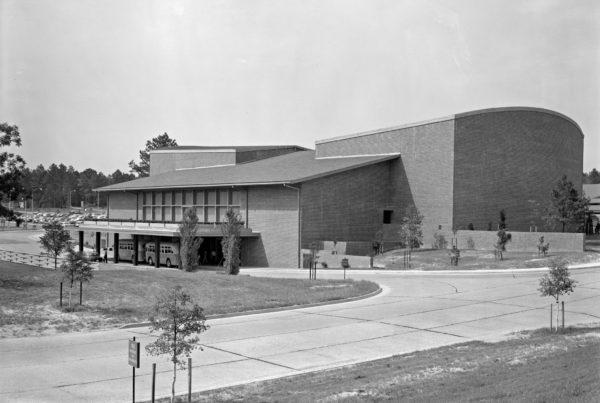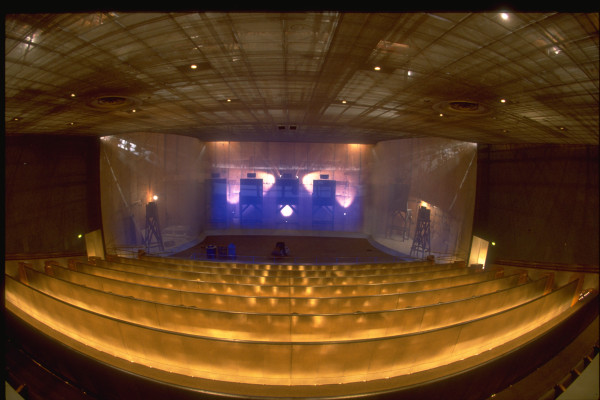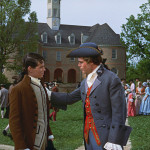
On this day, March 30, back in 1957, Colonial Williamsburg unveiled its new “Information Center,” with adjacent Motor House and Cafeteria-the state of the art for mid-20th century tourist facilities.
It also featured the debut of a theater custom-designed to showcase the new orientation film, The Story of a Patriot. That film, of course, still runs daily in the space now called the Visitor Center, and it is the longest-running movie in history.
The Information Center, sited on 40 acres that included a former golf course, was 10 years in the making and debuted in time for the celebrations marking 350 years since the first English settlement at Jamestown, just a few miles down the road.
Promotional materials boasted that the complex was “designed for 20th-century people, to meet 20th-century needs.” Among those needs were a swimming pool and parking for more than a thousand cars.
The Williamsburg Motor House included a dozen single-story buildings and a total of 200 air-conditioned rooms, each with floor-to-ceiling windows. (Today much of it is the Group Arrivals Building next to the Visitor Center.) The Cafeteria could serve 600 patrons per hour, and the Information Center featured nine exhibits concerning the restoration and 18th-century Virginia.
The grand opening of the center was quite an event, with chairman of the board Winthrop Rockefeller welcoming dignitaries that included Virginia’s governor, Thomas B. Stanley, U.S. Senator Absalom Robertson (father of Christian broadcaster Pat Robertson), the director of the National Park Service, and a substantial portion of the general assembly.
The placement of the Information Center away from the Historic Area was intentional. Visitation was swelling beyond the ability of the restored area to absorb the people.
And the cars. Duke of Gloucester Street at that point was still open to traffic, and in his remarks that evening Rockefeller spoke of the importance of prohibiting cars “to give visitors every opportunity to recapture their historic past.”
He also looked forward to the removal of Eastern State Hospital, whose buildings were scattered where the Art Museums stand today, to a location a few miles away. It was crucial, he insisted, to minimize modern distractions.
At 9:30 The Story of a Patriot premiered, introduced by director George Seaton and vice president of Paramount Pictures Frank Freeman explaining why the theater was so special.
New York Times film critic Bosley Crowther, was in attendance, and commented extensively on the innovative design: “The most striking aspect of the theatres, which seat 250 persons each… is the illusion of space inside them and the sense imparted of complete removal from the outside world.”

The screen was curved in a “radical arrangement” to make viewers feel that they were immersed in the events being depicted. Crowther noted the cast was largely “unfamiliar actors,” Jack Lord becoming the exception a decade later with his starring role in television’s Hawaii Five-O.
60 years ago, the project to help Americans make that imaginative leap of traveling back in time was still in its early stages. Our ideas, not to mention our means, of how to achieve the journey to the 18th century, have evolved. But like the nation’s aspirations to achieve the promise of our founding values, it remains a work in progress.

Dewitt YIngling says
I am so glad someone else remembered the Visitor Center audio-visual program. I remembered it was quite a welcome. It was so good, that in the 30+ times we have visited CW since 1985 I still get that feeling of expectation when I get to the visitor center just based on that one AV program. Thanks for sharing.
Dewitt YIngling says
Happy Birthday and Huzzah to “The Story of a Patriot” and the Visitor Center. Our first visit to CW was in 1985 and we will never forget the wonderful impression we received when we walked into the visitor center. At the time the visitor center had an audio-visual program that seemed to immediately grab you and transport you back in time as you walked in the building. Colonial characters appeared to surround you and immerse you in a way that set the tone for your visit. We were hooked. 1985 was the only year that we saw this welcoming audio-visual program. We were told that it had too many glitches and so it was discontinued. That was a shame as that was the high point in the visitor center’s ability to set the tone for visitors. It was loud so I suspect it might have become annoying to CW staffers working in ticket sales. That was also the last year that I remember the Visitor Center’s theater being used for lectures by CW staff. We attended several including one by CW’s architect, Mr. Pappas(?). Really spurred my interest.
Of course we loved “The Story of a Patriot” with its rich production values, soundtrack and history. No offense “Story” but we also love some of the quirky performances particularly by the Robert Fry character when he stiffly says “Thank You Sir” to his father. For decades now we have been happily quoting this and other favorite lines from the movie .
So “Thank You Sir” for pointing out the 60th anniversary of the movie. I have invited my children over tonight for a commemorative viewing of our dvd version of “The Story of a Patriot” and unless you are “so doltish and pusillanimous” you’ll do the same.
I remember the audio-visual display! The first time my husband and I went to CW, we somehow managed to walk in at the exact moment that all the people of the past were saying “Good Morning”! It was magical! We were both so disappointed when it disappeared.
Glenda Surrency says
A truly “affordable” package for stay and 3 meals would be a good thing! The Historic places are pricey ….and most people try to do at least one or two a visit . Woodlands is a good breakfast with room. I love the lodge and the package that includes breakfast.
I miss the cafeteria to this day. The food was pretty good and you could get a little or a lot to eat. It was very affordable. It was a life saver when at 20, I brought my 10 year old sister to CW for the first time. Breakfast was less expensive than the Holiday Inn 1776 breakfast and less waste, since both my sister and I didn’t eat much and I at 20 was watching the size of my hips. We could eat lunch and dinner there too. Which we did on several days during our week in the historic triangle. I know in Merchant’s Square there are places to eat at various price ranges. But I think a cafeteria on site would be a good idea. Yes, I know Golden Corral is down on By-Pass but you have to drive there and back if your plan is to continue touring the restored area. Instead getting on and off the bus.